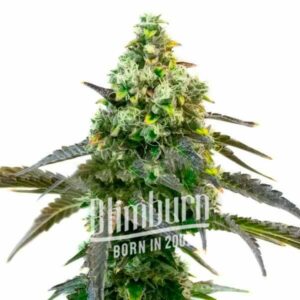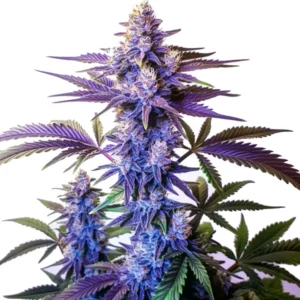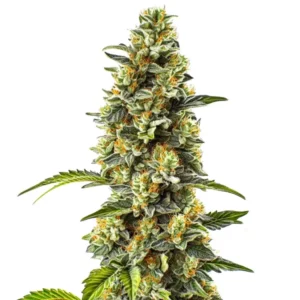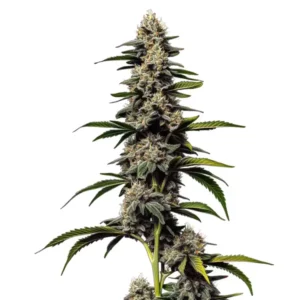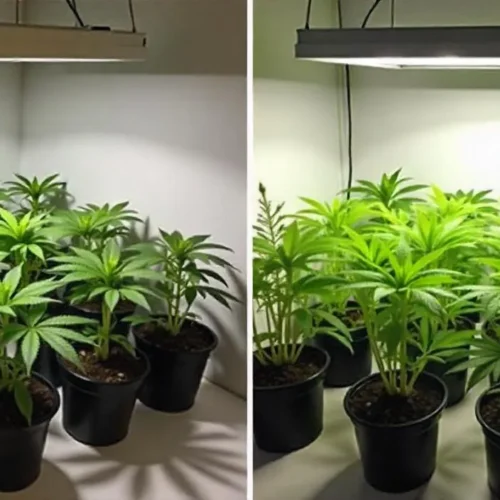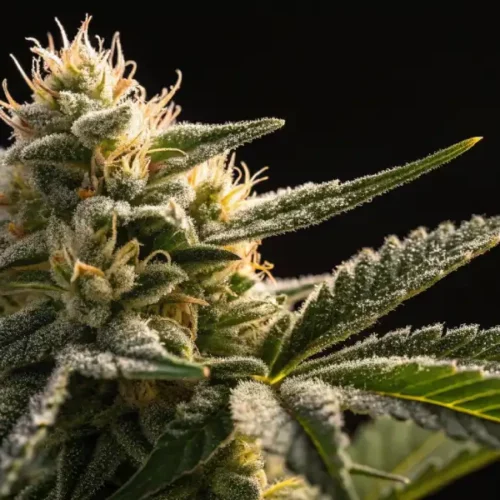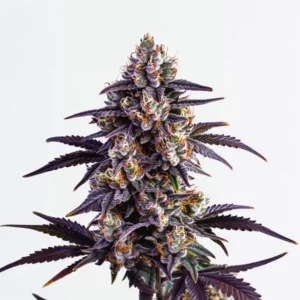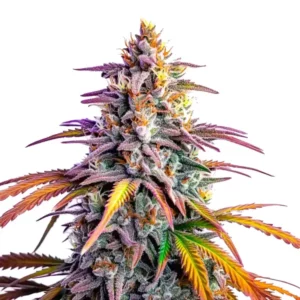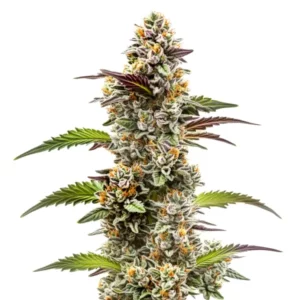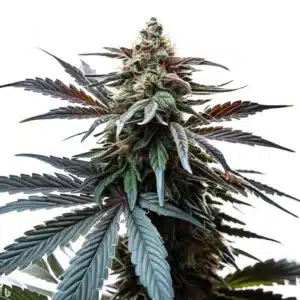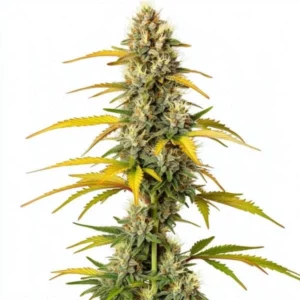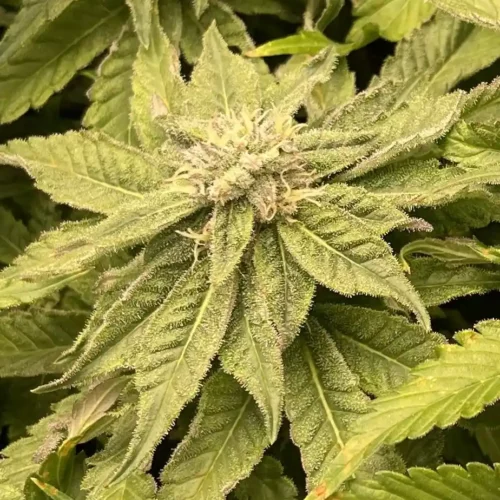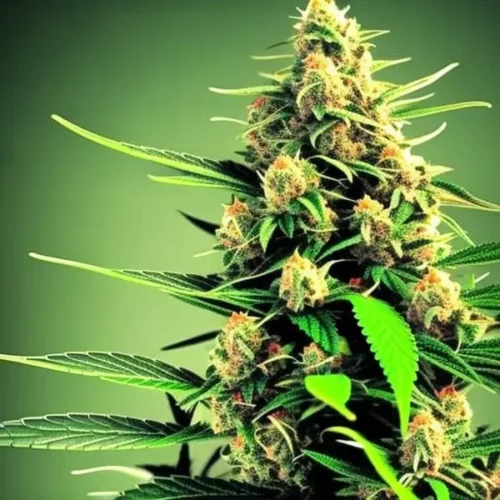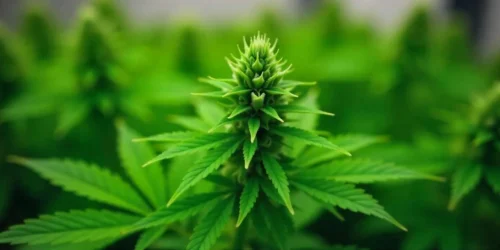Motor Breath Strain Cannabis Seed Description
Motor Breath is an in-demand cannabis variety renowned for its exceptional qualities, and it’s often discussed among popular strains in marijuana. A crossbreed of two potent strains, Chemdog and SFV OG Kush, Motor Breath Strain offers a balanced mix of Indica and Sativa traits. Its buds are dense, often displaying a stunning palette of green and orange hues, generously coated in glistening trichomes.
One of the standout features of Motor Breath strain is its striking aroma and flavor profile, with a distinctive, diesel-like scent. It combines earthy, diesel-like notes with hints of citrus and pine. This intricate fusion results in a delightful and memorable smoking experience.
Recommended Strains
Motor Breath
 THC: 30% - 33%
THC: 30% - 33% Type of seed: Feminized
Type of seed: Feminized Phenotype: Mostly Indica
Phenotype: Mostly Indica Day to flower: 8 - 10 weeks
Day to flower: 8 - 10 weeks
Motor Breath HMC Edition
 THC: 30% - 33%
THC: 30% - 33% Type of seed: Feminized
Type of seed: Feminized Phenotype: Mostly Indica
Phenotype: Mostly Indica Day to flower: 8 - 10 weeks
Day to flower: 8 - 10 weeks
Promos & Deals
Environmental Requirements for Growing Marijuana Motor Breath
Creating the perfect environment for your Motor Breath Strain plants, also known for its motor oil-like aroma, is essential for their successful cultivation. The strain’s environmental needs will help you provide optimal conditions for growth.
Motor Breath Seeds thrives in a temperate climate with daytime temperatures ranging between 70-80°F (21-27°C), slightly cooler at night. Maintaining stable temperature and humidity levels in your grow space is crucial to prevent stress and issues like mold or mildew.
Indoor growers should invest in high-quality LED grow lights or HPS lamps to ensure efficient photosynthesis and robust bud development. During the vegetative phase, provide 18-20 hours of light per day, transitioning to a 12-hour light and 12-hour darkness cycle to induce flowering.
For outdoor cultivation, choose a sunny and warm location, allowing Motor Breath Strain to reach its full potential, just like the renowned Motor Candy strain. In cooler climates, consider using a greenhouse or additional protection to extend the growing season and shield plants from adverse weather conditions.
Setting Up The Growing Cannabis Space
Creating an efficient and well-organized growing space is crucial before starting your Motor Breath cultivation. Whether indoors or outdoors, consider the following factors:
Indoor Cannabis Cultivation
For indoor growing, selecting an appropriate grow tent or dedicated grow room is vital. Ensure there is sufficient vertical space for plants to grow and maintain proper ventilation for fresh airflow. Install an efficient exhaust system with a carbon filter to control odors and manage heat and humidity levels. Use reflective materials or Mylar sheets to maximize light distribution and prevent light leaks during the flowering phase.
Select a suitable growing medium for MotorBreath weed Strain, such as high-quality soil or a hydroponic system, depending on your preferences and experience. Ensure proper drainage to prevent waterlogging and maintain a balanced pH level around 6.0-6.5 for optimal nutrient absorption.
Outdoor Cannabis Cultivation
When cultivating Motor Breath Strain outdoors, choose a location with ample sunlight and suitable soil conditions. Ensure well-draining soil rich in organic matter. Consider using large containers or fabric pots to maintain control over soil quality and root health. Protect your plants from strong winds by placing them near a fence or using windbreaks.
Using stakes or trellises to support your Motor Breath plants’ branches is recommended. This prevents branches from bending or breaking under the weight of dense buds and promotes better airflow.
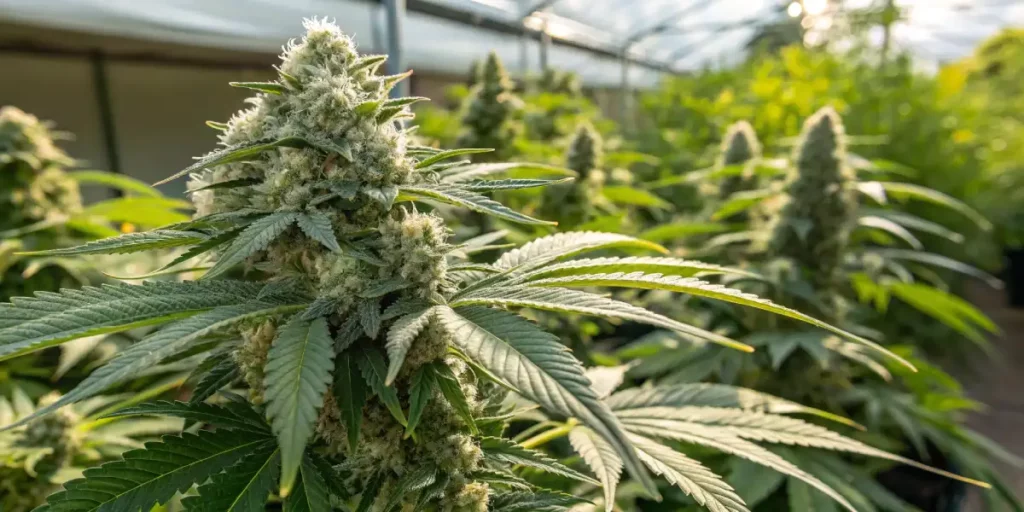
Propagation and Germination of Marijuana Seeds Motor Breath
Successful germination and propagation are crucial for robust Motor Breath Strain plants. Follow these steps to achieve a high germination rate and successful propagation:
- Begin with high-quality Motor Breath feminized seeds from a reputable seed bank. This ensures genetic stability and feminization.
- Initiate germination by soaking seeds in distilled water or a damp paper towel for 24-48 hours. Maintain a temperature between 70-85°F (21-29°C) and provide a dark, undisturbed environment.
- After seeds have developed taproots, carefully transfer them to a pre-moistened growing medium, such as a seedling tray or small pots filled with a well-draining soil mix.
- Place seeds in a warm, humid environment with gentle airflow. Maintain a temperature around 75-80°F (24-27°C) and humidity at 60-70% for optimal germination.
- Provide indirect light to seedlings during the first few days, gradually increasing light intensity as they develop. Avoid exposing them to intense light or heat that could cause stress or damage.
- Once seedlings have several sets of true leaves, transplant them into larger pots or final growing containers.
By following these germination and propagation steps, you can ensure a successful start for your Motor Breath weed plants, which are sometimes compared to strains like Motor Oil strain due to their robust characteristics.
Vegetative Phase of Cannabis seeds Motor Breath Strain
The vegetative phase plays a pivotal role in the development of your Motor Breath Strain plants, which is considered a top strain in marijuana. Consider the following key aspects during this stage:
Lighting: Provide this Strain plants with 18-20 hours of light per day during the vegetative phase to encourage vigorous growth. High-quality LED grow lights or HPS lamps are recommended for adequate light intensity and spectral distribution.
Nutrition: In the vegetative phase, Motor Breath Strain plants require a balanced, nutrient-rich diet. Use a reputable cannabis fertilizer with higher nitrogen (N) content to promote healthy leaf and stem growth. Follow the manufacturer’s instructions and monitor plants for nutrient deficiencies or excesses.
Watering: Water your plants when the top inch of soil feels dry. Avoid overwatering to prevent root rot and other moisture-related issues. Allow the soil to slightly dry between watering sessions while ensuring the plants do not experience extreme drought.
Training: Consider training techniques like low-stress training (LST) or topping to control plant height and shape. These methods create an even canopy, improve light penetration, and promote better bud development.
Pruning: Remove lower branches or leaves that receive minimal light or show signs of disease or pests. Enhance airflow and reduce the risk of mold or mildew formation.
By providing this Strain plants with the right environmental conditions, nutrition, and care during the vegetative phase, you establish healthy and robust plants ready for the flowering stage.
Flowering Phase of Marijuana Seeds Motor Breath Strain
The flowering phase is eagerly anticipated during the cultivation of MotorBreath Strain, as it’s when the characteristic buds develop. Here’s what you need to know:
Lighting: Adjust the light cycle to 12 hours of light and 12 hours of uninterrupted darkness to initiate flowering in your Motor Breath plants, resembling the process of growing other strains like Motor Candy. Use a timer for consistent light scheduling. During this stage, Motor Breath Strain plants require intense light, so ensure your grow lights cover adequately and maintain the appropriate distance from the canopy.
Nutrition: Transition from a nutrient formula higher in nitrogen to a bloom or flowering-specific nutrient formula. These formulations are typically richer in phosphorus (P) and potassium (K), promoting bud development and overall flowering performance. Monitor plants closely and adjust nutrient levels to avoid deficiencies or toxicities.
Temperature and Humidity: Maintain a slightly lower temperature during the flowering phase, ideally around 65-75°F (18-24°C), to encourage resin production and prevent heat-related stress. Humidity levels of 40-50% are ideal to minimize the risk of mold or bud rot.
Support: As Motor Breath weed plants enter the flowering phase, the weight of developing buds may cause branches to bend or break. Provide adequate support using stakes or trellises to ensure plants can withstand the weight and avoid bud damage.
Flowering Time: this Strain typically has a flowering time of 8-10 weeks, though this can vary based on the phenotype and environmental conditions. Monitor trichome development using a magnifying tool to determine the optimal harvest window.
Throughout the flowering phase, maintain a watchful eye for signs of pests or diseases. Implement proper pest management practices and take immediate action at the first sign of infestation or abnormalities.
Cannabis Fertilization and Nutrition – Motor Breath Strain
Proper nutrition and fertilization are critical for maximizing growth, yield, and overall health of your Motor Breath Strain plants. Consider these tips:
Choosing the Right Fertilizer: Select a high-quality cannabis-specific fertilizer or nutrient line providing a balanced blend of macro and micronutrients. Look for products rich in nitrogen (N), phosphorus (P), and potassium (K) to support healthy growth, root development, and bud formation.
Feeding Schedule: Follow the manufacturer’s instructions and adjust the feeding schedule based on your plants’ specific needs. Start with a lower concentration, gradually increasing it as plants progress through growth stages. Monitor plants for nutrient deficiencies or excesses and make adjustments as necessary.
Supplements and Additives: Consider incorporating supplements and additives into your feeding regimen to enhance specific aspects of plant development. These may include bloom boosters, beneficial microbes, enzymes, or organic amendments improving soil structure and nutrient availability.
Regularly monitor your plants’ response to the feeding program, adjusting nutrient concentrations and frequencies as needed. Remember to flush plants with pure water during the final weeks of the flowering phase to remove excess salts or nutrients, which can affect flavor and overall quality.
Pest And Disease Control for Cannabis Growing – Motor Breath Strain
While this Strain is known for its resilience, it can still be susceptible to pests and diseases. Implementing proper pest and disease control measures is crucial to protect your plants and ensure successful cultivation. Here are preventive and corrective actions:
Prevention:
- Regularly inspect your plants for signs of pests like spider mites, aphids, or thrips. Early detection is key.
- Maintain a clean growing space, removing dead plant material or debris that could harbor pests or pathogens.
- Introduce beneficial insects, such as ladybugs or predatory mites, to your garden for natural pest control.
- Ensure proper airflow and ventilation in the growing space to reduce the risk of mold or mildew.
- Quarantine new plants or clones before introducing them to your growing area to prevent the spread of pests or diseases.
Corrective Actions:
- If pests are detected, use organic or low-toxicity pest control products formulated for cannabis. Follow instructions carefully, avoiding harsh chemicals that could compromise harvest quality.
- For fungal diseases like powdery mildew or botrytis, remove infected plant material, improve airflow, and consider organic fungicides or natural remedies like neem oil or a milk spray solution.
- When facing severe infestations or persistent diseases, consult with a professional grower or horticulturist for tailored advice and appropriate solutions.
Harvesting and Curing for Cannabis Growing – Motor Breath Strain
Harvesting your Motor Breath Strain at the right time and properly curing the buds are critical steps to preserve their aroma, flavor, and potency. Follow these guidelines:
Trichome Maturity: Use a magnifying tool to examine trichomes on the buds. Wait until they have reached the desired maturity, indicated by a milky or cloudy appearance with some amber trichomes. This ensures the optimal balance of cannabinoids and terpenes.
Harvesting: Use clean, sterilized pruning shears or scissors to cut branches one by one. Be careful not to damage the buds during the process. Remove large fan leaves, but leave smaller sugar leaves intact, as they contribute to the final bud structure.
Drying: Hang harvested branches upside down in a dark, well-ventilated area with a temperature of 60-70°F (15-21°C) and humidity levels at 50-60%. Ensure proper airflow and avoid overcrowding to prevent mold or mildew. Drying typically takes 7-14 days, depending on environmental conditions.
Curing: After branches have dried, carefully remove buds from stems and place them in airtight glass jars. Store jars in a cool, dark place with a temperature around 60-70°F (15-21°C) and humidity at 58-62%. Open jars daily for the first week to allow excess moisture to escape, gradually reducing the frequency to once every few days. Curing usually takes 2-4 weeks or longer for optimal flavor and potency development.
Proper harvesting and curing techniques significantly contribute to the overall quality of your Motor Breath weed buds. Take your time, be patient, and enjoy the rewarding process of transforming your harvest into a premium product.
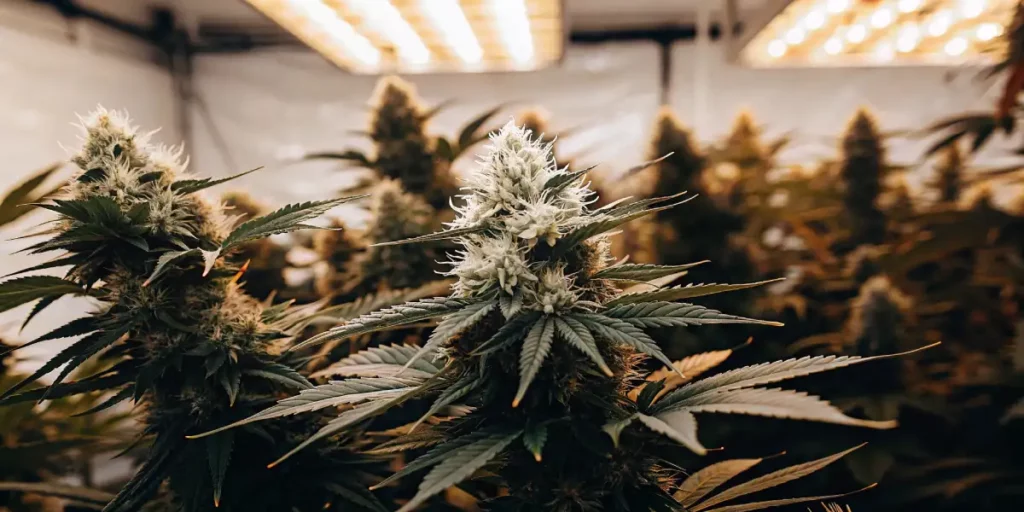
Motor Breath Strain: Indica or Sativa?
This Strain is a hybrid cannabis strain offering a balanced blend of Indica and Sativa effects. The exact ratio can vary depending on the phenotype or breeder’s selection, but it is generally considered a hybrid with slight Indica dominance.
While Motor Breath Strain delivers a relaxing body high characteristic of Indica strains, it also provides cerebral effects and euphoria commonly associated with Sativa strains. This combination of effects contributes to the strain’s popularity and versatility among cannabis enthusiasts.
Whether you seek a soothing experience or a burst of creativity and sociability, Motor Breath Strain offers a well-rounded and enjoyable effect catering to a wide range of preferences.
Advantages of Growing Motor Breath Strain Cannabis Strain
Growing Motor Breath seeds offers several advantages that make it an attractive choice for cannabis cultivators:
- High-quality buds with a unique aroma and flavor profile.
- Balanced hybrid effects suitable for various occasions.
- Resilient and vigorous growth.
- Availability of feminized seeds.
- Adaptability to different growing environments (indoors and outdoors).
- Relatively short flowering time compared to other strains.
- Good resistance to pests and diseases.
Disadvantages of Growing Motor Breath Seeds
While Motor Breath seeds has many benefits, growers should be aware of potential challenges:
- Potential for a strong odor during flowering, necessitating proper odor control measures.
- Requires precise monitoring of nutrient levels to prevent nutrient burn.
- May require additional support for branches due to heavy bud development.
- Some phenotypes may have lower yields compared to other strains.
Even with these potential challenges, growing Motor Breath cannabis seeds can be a rewarding experience if you’re ready to tackle these factors. By being aware of the pros and cons of cultivating this strain, you can take proactive steps to ensure success.
Why buy Motor Breath Seeds
Purchasing Motor Breath seeds from a reputable seed bank offers several benefits:
Genetic Consistency: Reputable seed banks provide genetically stable and feminized seeds, ensuring that your plants will exhibit the expected characteristics of Motor Breath Strain.
Variety Selection: Seed banks often offer a wide selection of cannabis strains, allowing you to choose from different varieties and find the one that best suits your preferences and needs.
Quality Assurance: Established seed banks typically prioritize quality control, which means you are more likely to receive high-quality, viable seeds that have been stored and handled correctly.
Customer Support: Many seed banks offer customer support and guidance, which can be valuable for novice growers or those looking for strain-specific advice.
Discreet Shipping: Most reputable seed banks provide discreet and secure shipping options to protect your privacy.
When buying Motor Breath Strain marijuana seeds, research different seed banks, read customer reviews, and choose one with a solid reputation to ensure a positive purchasing experience.
Problems in Cultivation Motor Breath Strain Cannabis Seeds
While cultivating Motor Breath seeds can be a rewarding endeavor, growers may encounter various challenges. Some common problems include:
Odor Control: Motor Breath Strain is known for its potent aroma during flowering. Inadequate odor control measures can result in unwanted attention or odor-related issues. Consider using carbon filters and exhaust systems to manage odors effectively.
Nutrient Management: Overfeeding or nutrient imbalances can lead to nutrient burn, nutrient lockout, or other growth issues. Carefully monitor nutrient levels, pH, and follow recommended feeding schedules to avoid problems.
Pests and Diseases: Despite its resilience, Motor Breath Strain can still fall victim to pests like spider mites or diseases like powdery mildew. Regularly inspect your plants and implement preventative measures to keep them healthy.
Environmental Factors: Extreme temperatures, humidity fluctuations, or light stress can harm your plants. Maintain stable environmental conditions and address any issues promptly.
Support for Heavy Buds: Motor Breath Strain’s dense buds can become heavy, causing branches to bend or break. Use stakes, trellises, or other support systems to prevent damage.
Yield Variability: Depending on the specific phenotype and growing conditions, yield can vary. Some plants may produce lower yields than others.
Legality: Ensure you are complying with your local laws and regulations regarding cannabis cultivation and possession.
By being aware of these potential problems and taking proactive steps to address them, you can increase your chances of a successful Motor Breath Strain cultivation.
Cultivating Motor Breath Strain cannabis seeds can be a rewarding journey for both novice and experienced growers. By following the guidelines and tips provided in this cultivation advice table, you can nurture healthy plants, optimize yields, and enjoy the unique aroma and effects of this popular cannabis strain. Remember that patience, attention to detail, and a love for the plant are key to a successful harvest.
FAQS
What is the optimal temperature for growing Motor Breath strain?
Motor Breath thrives in a temperate climate with daytime temperatures between 70-80°F (21-27°C). At night, temperatures should be slightly cooler. Maintaining stable temperatures and humidity levels is key to avoiding stress, mold, or mildew issues.
How long does the Motor Breath strain take to flower?
Motor Breath typically flowers within 8-10 weeks. During this phase, it’s important to adjust the light cycle to 12 hours of light and 12 hours of darkness to trigger flowering. Monitoring trichome development will help determine the optimal harvest time.
Can Motor Breath be grown indoors or outdoors?
Motor Breath can be successfully cultivated both indoors and outdoors. Indoor growers should ensure adequate space, ventilation, and lighting to replicate optimal conditions. Outdoor cultivation requires a sunny, warm location, with protection in cooler climates to extend the growing season.
What training techniques are best for Motor Breath strain?
To manage Motor Breath’s growth, it’s recommended to use training techniques such as low-stress training (LST) or topping. These methods help control plant height, create an even canopy, and improve light penetration, leading to better bud development.
What are the most common problems when growing Motor Breath, and how can I solve them?
Common issues include managing its strong odor during flowering, nutrient imbalances, and pest infestations. Solutions include using carbon filters for odor control, carefully monitoring nutrient levels to prevent nutrient burn, and practicing regular pest inspections and preventative measures to keep your plants healthy.



